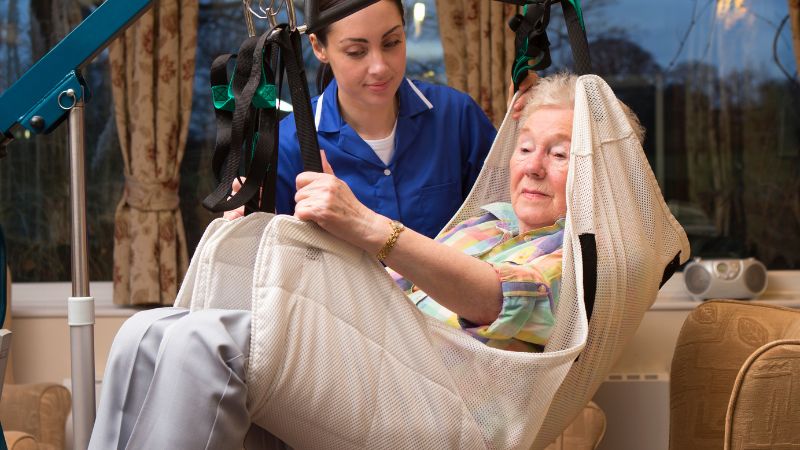Powered patient hoists are essential medical devices designed to safely lift and transfer patients with limited mobility. These devices are crucial in healthcare settings, including hospitals, nursing homes, and home care, where they enhance the quality of care and safety for both patients and caregivers. This comprehensive guide delves into the various aspects of powered patient hoists, providing detailed information on their types, benefits, technical specifications, and much more.
Ensure safety and comfort with powered patient hoists! Ideal for hospitals, nursing homes, and home care, they simplify patient transfers and reduce caregiver strain.
Rent a Cure Services Tweet
Invaluable Tools in Modern Healthcare
Powered patient hoists are invaluable tools in modern healthcare, enhancing the safety, efficiency, and quality of care for patients with limited mobility. By understanding the different types, benefits, technical specifications, and safety standards, caregivers can make informed decisions and provide the best possible care. As technology advances, the future holds even greater potential for these essential devices, promising improved patient outcomes and caregiver experiences.
Types and Categories
Manual Hoists
Manual hoists require physical effort to operate. They are less expensive but demand more from caregivers.
Powered Hoists
Powered hoists are electrically operated, providing a smoother and less strenuous experience for both patients and caregivers.
Ceiling Hoists
Ceiling hoists are installed on tracks mounted to the ceiling, offering a space-saving solution ideal for rooms with limited floor space.
Mobile Hoists
Mobile hoists are portable and can be moved from room to room, providing flexibility in various care settings.
Pool Hoists
Designed specifically for aquatic environments, pool hoists assist in transferring patients in and out of swimming pools.
Bariatric Hoists
Bariatric hoists are designed to support heavier patients, typically featuring higher weight capacities and reinforced structures.
Paediatric Hoists
These hoists are tailored for children, offering smaller slings and frames to ensure safety and comfort.
Components of Powered Patient Hoists
Hoist Frame
The hoist frame is the structure that supports the lifting mechanism and patient, made from durable materials like steel or aluminium.
Lifting Mechanism
The lifting mechanism can be a hydraulic system in manual hoists or an electric motor in powered hoists, responsible for raising and lowering the patient.
Control System
Powered hoists come with a control system, often a hand-held remote, allowing caregivers to operate the hoist safely and efficiently.
Slings
Slings are fabric harnesses that support the patient during lifts. They come in various sizes and styles to accommodate different needs.
Batteries and Charging System
Powered hoists rely on rechargeable batteries. A reliable charging system ensures the hoist is always ready for use.
Applications in Different Settings
Hospitals
In hospitals, powered hoists are used for patient transfers between beds, wheelchairs, and examination tables.
Nursing Homes
Nursing homes utilize hoists to enhance the mobility of residents, facilitating daily activities like bathing and toileting.
Home Care
Powered hoists enable caregivers to provide professional-level care at home, promoting independence and comfort for patients.
Rehabilitation Centres
Rehabilitation centres use hoists to assist patients in therapeutic exercises and recovery processes.
Special Needs Schools
These schools incorporate hoists to support students with mobility challenges, ensuring they can participate in educational activities safely.
Benefits of Powered Patient Hoists
Safety for Patients
Hoists minimize the risk of falls and injuries during transfers, ensuring a safe and secure lifting process.
Reduced Risk of Injury for Caregivers
By handling the physical strain of lifting, hoists reduce the likelihood of musculoskeletal injuries among caregivers.
Increased Mobility and Independence for Patients
Powered hoists enable patients to move more freely and comfortably, enhancing their overall quality of life.
Efficiency in Caregiving
Hoists streamline the transfer process, allowing caregivers to perform their duties more efficiently and with less physical effort.
Challenges and Limitations
Cost
Powered hoists are more expensive than manual ones, which can be a barrier for some healthcare facilities and individuals.
Maintenance Requirements
Regular maintenance is essential to keep hoists in optimal working condition, requiring time and resources.
Training for Caregivers
Proper training is necessary to ensure caregivers can operate hoists safely and effectively.
Space Constraints
Ceiling hoists and mobile hoists require adequate space for installation and use, which may be a limitation in smaller settings.
FAQs
A powered patient hoist is an electrically operated device used to lift and transfer patients with limited mobility.
Powered hoists use electric motors to lift patients, controlled via hand-held remotes or integrated systems.
Yes, powered hoists are designed with multiple safety features to ensure safe operation for both patients and caregivers.
Slings come in various sizes and styles, including full-body, split-leg, and hygiene slings, to suit different transfer needs.
Consider factors like weight capacity, range of motion, space availability, and specific patient needs when choosing a hoist for home use.

